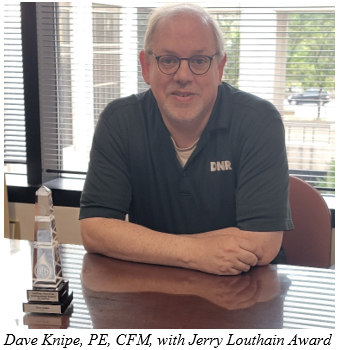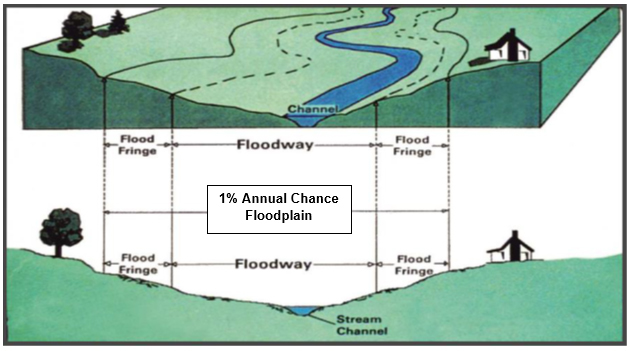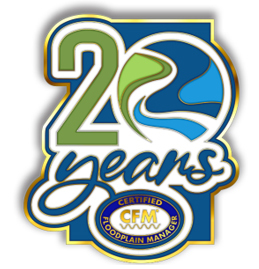|
Association of State Floodplain Managers (ASFPM) Conference
By Doug Wagner, Division of Water
The Association of State Floodplain Managers resumed its in-person annual conference in May. This conference is the world’s largest and most comprehensive floodplain management conference and was held in Orlando, Florida. This 46th annual conference set records for in-person attendance with 1,362 in-person attendees and with 411 virtual attendees. This year’s theme was Shining Light on Mitigation. Staff that attended were able to attend sessions on: Coastal Issues, Dams & Levees, Mapping, Mitigation, Modeling, Natural & Beneficial Functions, NFIP, Post-Disaster, Risk Communication, Social Justice, and Stormwater & Urban Flooding. The conference offered 240 concurrent sessions, workshops, policy discussions, plenary sessions, and networking opportunities.
DNR sent two staff to the in-person conference and three others attended virtually by using grant monies provided by FEMA. These staff members attended several different sessions, allowing them to bring information back to the division to improve state support for local programs and our mapping initiatives. Two division staff also received awards at the Thursday awards program.
Dave Knipe, Director, Division of Water received the Jerry Louthain Award for Distinguished Service to ASFPM. In 1995, the board established the award, which is the highest ASFPM gives to recognize individuals who, through their long-term efforts, have clearly supported and advanced the work of the Association of State Floodplain Managers.
Award text provided by ASFPM:
“Dave served as Mapping and Engineering Standards Committee co-chair for decades. As an ASFPM representative, he closely followed and kept us informed of the evolution of Risk Mapping to newer versions, actively participated and engaged FEMA during the FEMA Operating Partners quarterly meetings and was an anchor for ASFPM recommendations to FEMA on flood mapping. He was instrumental in supporting not just mapping but helping with other Association initiatives like the Natural Floodplain Function Alliance and many other elements. Dave was heavily involved in setting up the Cooperating Technical Partners (CTP) Sub-Committee under the Mapping and Engineering Standards Committee, with who he also freely shared, as an example of best practice, the Indiana DNR CTP award winning Floodplain Information Portal.”
 Doug Wagner, Senior Planner with the Floodplain Management Section, was awarded the John Ivey Award for Superior Efforts in Certification. This award was established by the ASFPM Board of Directors in 2001 to recognize exceptional efforts to promote the professional certification of floodplain managers. Any individual, agency or organization is eligible. The award was named after Ivey because he was serving as our Professional Development Committee chair in the mid-1990s and was instrumental in the Certified Floodplain Manager (CFM) exam development and rollout.
Award text provided by ASFPM:
“”What does it mean to be a CFM?” This question was posed surreptitiously to this year’s John Ivey Award winner. He didn’t know it was for his nomination, but here’s what he said, in part: “Being a CFM demonstrates to others that I hold myself to a set of higher standards, observe ethical standards when making floodplain management decisions and consistently participate in continuing education for the National Flood Insurance Program and Floodplain Management. It means collaboration with other CFMs when unusual events and circumstances arise….”
Wow…that’s awesome. I think these past two years would qualify as quote “unusual events and circumstances” but this year’s winner didn’t let it deter his education and outreach efforts. He just had to rethink how he could accomplish his goals, despite everyone working remotely.
And so, he developed a series of online webinars and opened them up to floodplain managers, local elected officials, architects, engineers, surveyors, developers, home builders and contractors. The result? More than three times as many people attended than usual. He earned his Certified Floodplain Manager certificate in 2014 and remains a practicing CFM, working to serve the people throughout his state. In addition to presenting webinars, he serves as the Editor of Waterlines, the DNR Water Division’s quarterly newsletter and was a contributor to the state’s updated Floodplain Administrator’s Guidebook and Post Flood Guidance for Local Floodplain Administrators.”

 Development
By Alyssa Damiano, Division of Water
National Flood Insurance Program (NFIP) participation requires every community to adopt and enforce a floodplain ordinance that establishes a floodplain development permit. All development activities in the floodplain must get a permit prior to development commencement. Remember, when any development takes place in the floodway portion of the Special Flood Hazard Area (SFHA), a permit or letter of authorization is needed from the DNR before any local permits can be issued and development can start. Development activities in the fringe portion of the SFHA only require local permits. In some instances, the developer may need DNR to delineate the floodway and fringe for the site in question.
If you wish to determine the flood risk for your property or area of development, you can do so using the Indiana Floodplain Information Portal (INFIP). The tool will show the special flood hazard areas that are mapped on the Flood Insurance Rate Map and DNR’s Best Available Floodplain Layer for jurisdictional streams. Jurisdictional streams are any stream with an upstream drainage area of 1 square mile or greater. The portal can be accessed here: infip.dnr.IN.gov
 Development means, for floodplain management purposes, any man-made change to improved or unimproved real estate including but not limited to:
- Construction, reconstruction, or placement of a structure or any addition to a structure;
- Installing a manufactured home on a site, preparing a site for a manufactured home, or installing a recreational vehicle on a site for more than 180 days;
- Installing utilities, erection of walls and fences, construction of roads, or similar projects;
- Construction of flood control structures such as levees, dikes, dams, channel improvements, etc.;
- Mining, dredging, filling, grading, excavation, or drilling operations;
- Construction and/or reconstruction of boat lifts, docks, piers, and seawalls;
- Construction and/or reconstruction of, bridges or culverts;
- Storage of materials; or
- Any other activity that might change the direction, height, or velocity of flood or surface waters.
“Development” does not include activities such as the maintenance of existing structures and facilities such as painting; re-roofing; resurfacing roads; or, gardening, plowing, and similar agricultural practices that do not involve filling, grading, excavation, or the construction of permanent structures. Keep in mind that maintenance activities are included when completed concurrently with other repairs, additions, or improvements for substantial damage/substantial improvement calculations.
ASFPM Recognizes CFMs
By Doug Wagner, Division of Water

The Association of State Floodplain Managers (ASFPM) recognized Certified Floodplain Managers (CFMs) at their 2022 Annual Conference. David Knipe PE, CFM and Anita Nance, CFM, Division of Water were two of 250 nationally and two of nine in Indiana recognized for 20+ years of service as a Certified Floodplain Manager.
Anita began her career with the division in January 1995 as an intermittent Engineering Assistant with what is now the Water Rights and Use Section. In May of that year, she became a full-time Engineering Assistant in the then Permit Administration Section. In February of 1997, she joined the Floodplain Management Section as the Southern Planner. She has since served as the Senior Planner, National Flood Insurance Program (NFIP) State Coordinator, and currently serves as the Section Manager for the Floodplain Management Section. Anita always felt that it was difficult to encourage local administrators to obtain their CFM if our staff were not also certified. Anita was the first state employee to become a CFM, receiving her certificate in September of 2000.
Dave began with the Hydraulic & Hydrologic Section in 1992, later serving in the Engineering Services Section for several years and is now the Division Director. Dave has been instrumental in floodplain mapping and coordinating the Cooperating Technical Partners Program for the division. He is also recognized as a national leader in floodplain mapping and coordination with ASFPM’s mapping standards committee. Dave earned his certificate in November of 2001.
The ASFPM national certified floodplain manager program was established in 1998 to create a baseline testing of professional competence in floodplain management. The program requires passing an exam and then continuing education credits annually to maintain certification. Recognizing training/continuing education/professional development is a keystone of the program, as the floodplain management program is continually evolving and the knowledge and performance of local, state, federal and private-sector floodplain management professionals is everchanging.
The role of the nation’s floodplain managers is expanding due to increases in disaster losses, the emphasis on mitigation to alleviate the cycle of damage-rebuild-damage, and a recognized need for professionals to adequately address these issues. This certification program lays the foundation for ensuring that highly qualified individuals are available to meet the challenge of breaking the damage/rebuild cycle on the nation’s human, financial, and natural resources.
We encourage communities to have CFMs on staff to review or assist in review of all development in their Special Flood Hazard Areas (SFHAs). By having a CFM on staff, communities are taking steps to ensure that they are permitting development in their SFHAs correctly. CFMs also participate in continuing education, which leads to professional administration of the community’s flood hazard regulations required by the NFIP.
If you are interested in becoming a CFM or want to learn more about the requirements and exam you can visit ASFPM’s website here: https://www.floods.org/certification-program-cfm/
|
Upcoming Training Opportunities
Association of State Floodplain Managers (ASFPM) Launches New Website
Ninety percent of all natural disasters in the United States involve flooding, making flooding the nation’s most common and costly disaster. And the trends are worsening. Fueled by climate change, extreme rainfall events and sea level rise will continue at a frightening pace, putting millions of people in the path of destructive floods.
On May 16, to help property owners, particularly those in flood-prone areas, understand their flood risk and the most effective flood mitigation strategies for their particular property, the Association of State Floodplain Managers (ASFPM) launched Reduce Flood Risk, an interactive flood mitigation resource library.
At the heart of Reduce Flood Risk is a decision-making engine that guides property owners through a series of questions to help them understand their current flood risk and the specific steps they can take to better protect their home or business.
The mitigation options on Reduce Flood Risk can be filtered by key attributes, such as cost, complexity, and level of required maintenance. The site also features a variety of resources on flood risk, flood insurance, financial assistance options, and whom to contact with questions, as well as links to more in-depth information and guidance. The site is completely free, and users don’t need to create an account to gain access to the resources.
“To the average property owner, flood risk mitigation can feel like an overwhelming task. People often tell us they don’t even know where to start, so they put it off until it’s too late,” said Chad Berginnis, ASFPM executive director. “One of the goals of Reduce Flood Risk is to put people on a path toward understanding their flood risk and arming them with the tools they need to reduce that risk. And for those who think they’ll never flood, keep in mind that 40% of federal flood insurance claims occur outside of high-risk areas.”
Curated resources and custom recommendations
One of the big problems Reduce Flood Risk solves is in simplifying the information-gathering process. Although there are a multitude of mitigation resources available to help individuals and communities reduce their flood risk, most of these resources are scattered across numerous federal and state agency websites, making it nearly impossible for property owners to find specific strategies tailored to the location and features of their home or business.
By curating the best mitigation resources available on the web and creating a centralized, searchable library, Reduce Flood Risk empowers property owners to protect themselves and their most valuable assets.
Funded by the Federal Emergency Management Agency’s (FEMA) Office of the Flood Insurance Advocate, ASFPM developed the Reduce Flood Risk with input from representatives from FEMA, US Army Corps of Engineers, ASFPM committees, and academia.
ASFPM officially launched Reduce Flood Risk on the opening day of its 46th annual conference. Held in Orlando, May 15-19, the conference brought together nearly 2,000 flood risk management professionals from across the country. It’s considered the world’s largest and most comprehensive floodplain management conference, and this year’s theme was Shining Light on Mitigation.
About ASFPM
Founded in 1977, the Association of State Floodplain Managers (ASFPM) is a scientific and educational nonprofit organization dedicated to reducing flood loss in the nation. ASFPM and its 38 chapters represent approximately 20,000 state and local officials as well as other professionals engaged in all aspects of floodplain management and flood hazard mitigation, including management of local floodplain ordinances, flood risk mapping, engineering, planning, community development, hydrology, forecasting, emergency response, water resources development, and flood insurance. Visit floods.org/ to learn more.

(Information from FEMA, ASFPM, and other websites)
Association of State Floodplain Managers (ASFPM)
ASFPM has an online training program and new training is added regularly. See floods.org/training-knowledge-center/ for more information.
FEMA’s Emergency Management Institute (EMI)
In-person classes are resuming at EMI after most had been canceled or held virtually last year. EMI still offers many courses through webinar training opportunities. Currently E0273: Managing Floodplain Development through the NFIP is scheduled for July and December of 2022, and February, May and August of 2023. For additional information on EMI classes and webinars, please visit EMI’s training calendar website at training.fema.gov/emicourses/schedules.aspx and its course catalog at firstrespondertraining.gov/frt/npccatalog/EMI.
FEMA Region 5 announces new and continued training opportunities
FEMA Region 5's Flood Insurance Liaison will be hosting a series of webinars about flood insurance through the NFIP and the NFIP's new pricing methodology known as Risk Rating 2.0: Equity in Action. In most cases, there is a 30-day waiting period before flood insurance policies become effective. Start your preparations early by learning more about flood insurance today.
FEMA Region 5 is conducting regular webinars to educate and train community officials on managing their community’s floodplains, on various topics such as floodplain management, flood insurance, and National Flood Insurance Program (NFIP) requirements. Each webinar will run one hour and 1 ASFPM CFM CEC is available by attending a session. The virtual webinar is open to all; however, local and county officials working in emergency management, building code administration, and floodplain management are strongly encouraged to attend. The webinar is presented by FEMA Region 5’s Mitigation Division, Floodplain Management and Insurance Branch.
For more information on either series or to register visit our events and training page at dnr.IN.gov/water/events-and-training.
STATE TRAINING OPPORTUNITIES
Other Upcoming Events and Training
For other upcoming events and training hosted by the DNR Division of Water, check out our events and training page on our website dnr.IN.gov/water/events-and-training. We will be posting training videos and other opportunities as they are developed or scheduled.
The DNR Division of Water will present Variances and the NFIP on June 14 from 9 to 11 a.m. ET, and June 15 and 21 from 2 to 4 p.m. ET. All of these events will be virtual Teams meetings. The workshop will also be held as a hybrid event on June 22 from 10 a.m. to noon ET in conference room 22 of the Indiana Government Center South. These workshops should be attended by local floodplain administrators, board of zoning appeals members, and any planning, zoning, and building staff. You can register for the event at forms.office.com/g/nY1iKeQWAw.
Indiana Department of Homeland Security
Please visit the Indiana Department of Homeland Security’s training calendar for upcoming courses and trainings at oas.dhs.IN.gov/hs/training/public/calendar.do.
|
THANK YOU
Thanks to those contributing to this issue: Dave Knipe, Jennifer Ware, Anita Nance, Darren Pearson, Alyssa Damiano, Marty Benson, Don Kaczorowski, and Ed Reynolds.
Editor – Doug Wagner
The work that provides the basis for this newsletter was supported by funding under a cooperative agreement with the Federal Emergency Management Agency. The author and publisher are solely responsible for the accuracy of the statements and interpretations contained in the publication. Such interpretations do not necessarily reflect the views of the federal government.
Waterlines is produced quarterly as a public service by the DNR Division of Water.
Waterlines is available on the Web at dnr.IN.gov/water/publications/waterlines-newsletter/.

Having trouble viewing this email? View it as a Web page.
|